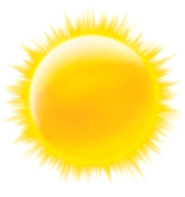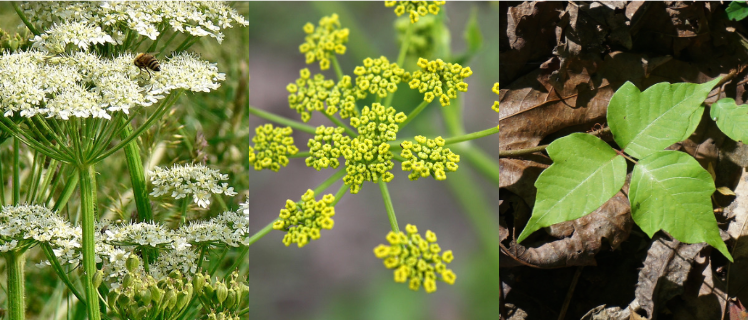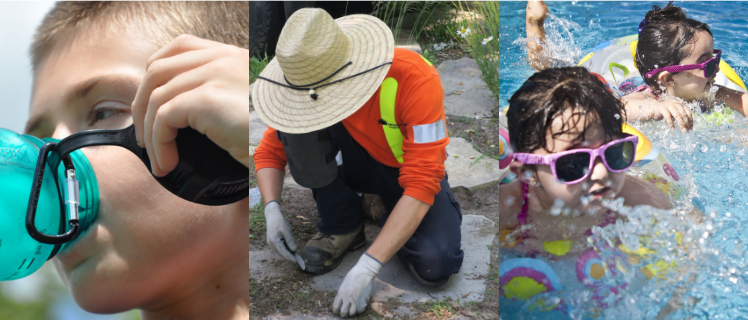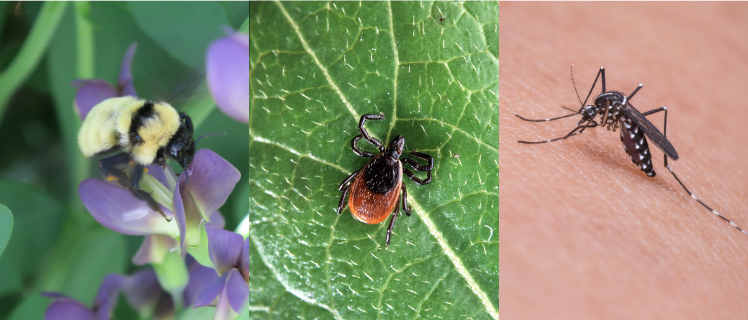Summer safety tips for you and your family

Poisonous plants
Giant hogweed
Giant hogweed is a poisonous and invasive plant found in Atlantic Canada, Ontario, Quebec and British Columbia. If you come in contact with this plant, you could experience severe burns to your skin. Contact with the eyes can cause temporary or permanent blindness.
- Height: one to 5.5 metres.
- Leaves: Large, deeply cut with sharp coarse teeth, reaching widths in excess of one metre.
- Stems: Covered in coarse, whisker-like hairs with red/purple spots.
- Flowers: White, umbrella shaped, up to 1.2 metres across.
Wild parsnip
Similiar to Giant hogweed, Wild parsnip is a poisonous and invasive plant that is found in most Canadian provinces. If you come in contact with this plant, you could experience severe burns to your skin. Contact with eyes can cause temporary or permanent blindness.
- Height: one to two metres.
- Leaves: Pinnately compound with two-five pairs of opposite, sharply toothed leaflets.
- Stems: Completely smooth and reddish/green in colour.
- Flowers: Yellow, umbrella shaped, 10-20 cm across. Similar in appearance to dill.
When working near these plants:
- Wear googles, rubber gloves, rubber boots and Tyvek coveralls.
- Make sure to bring a bucket, soap, water and a scrub brush, and thoroughly wash rubber boots and gloves before taking off all of your protective clothing.
If you come into contact with these plants:
- Seek immediate shelter (exposure to sap makes human skin hypersensitive to sunlight).
- Thoroughly wash exposed skin with soap and water.
- If skin reacts, seek medical attention.
Learn more at www.weedinfo.ca

Heat Stress
Heat stress can be deadly. Symptoms include weakness, fatigue and dizziness. Protect yourself using these protocols:
- Drink plenty of water – a cup every 15 to 20 minutes.
- Avoid caffeine or alcohol which can dehydrate you.
- Wear light, loose clothing, UV rated sunglasses and a wide brim hat.
- Schedule more breaks to rest and cool off in the shade or in air-conditioned buildings or vehicles.
- Don’t over-exert yourself.
- Use sunscreen with a Sun Protection Factor (SPF) of at least 30 and UVA / UVB protection.
- Reapply sunscreen every two hours after sweating.
- Avoid the sun and strenuous tasks between 11:00 a.m. and 4:00 p.m. by scheduleing work for the cooler part of the day.
- Work with your supervisor to gradually increase time in the sun instead of suddenly increasing sun exposure.
- Set up shade structures in the vicinity or use umbrellas, buildings, or trees to shield you from the sun.
For additional information on heat stress at work, visit the Ministry of Labour's web page.

Ticks, Lyme disease and Alpha-Gal Syndrome
Lyme disease
Ticks that may cause Lyme disease can be found throughout our area. It is important to protect yourself. Lyme disease is caused by the bite of a black legged tick infected with the bacteria. The tick needs to be attached for 24-36 hours before it is able to transfer the bacteria.
A red rash may appear from three days to several weeks following the bite; a bulls-eye rash may be present in the area of the bite. You may also have a fever with the rash.
Symptoms of the disease may include bull's eye rash, fever, headache, fatigue, muscle and joint pain. These may disappear within 10 days. But if left untreated, Lyme disease can progress and affect the nervous system, joints and the heart.
If you develop symptoms of Lyme disease, consult your health care provider.
Alpha-Gal Syndrome
The Lone Star tick has been observed for the first time in Ontario this year. This tick can cause Alpha-Gal Syndrome, which can cause humans to develop an allergy to red meat. Reactions are delayed and can be severe.
For additional Information, visit Ticksafety.com
Look for ticks
- When you return from being outdoors, check yourself for ticks (include armpits, groin, scalp and have someone else check the back of your body).
- A quick shower may help remove any ticks not yet attached.
- Outdoor clothes can be put into a hot dryer to kill loose ticks.
- If you are going hiking or walking in natural areas, wear light coloured clothing, long-sleeved shirts, long pants, socks and shoes.
- Tuck your pants into your socks.
- Ticks are more visible on light colours and harder to attach on clothing.
Check your ticks
Unfed tick
Fed (engoraged) tick
Remove your ticks
- Don’t squeeze the tick or try to burn it off or put anything on it.
- Grasp the tick by the head as close to your skin as possible.
- Pull it straight out, gently but firmly. Use tweezers if possible.
- Thoroughly clean the bite area (use soap and water or a disinfectant).
- Make note of the date you removed the tick.
